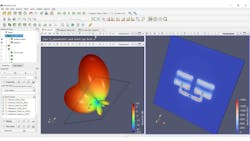CENOS Seeks to Democratize Antenna Simulation
Riga, Latvia-based CENOS appeared on the scene in 2017 with its first electromagnetics simulation software, which focused on induction-heating applications. Users appreciated the tool’s simple, straightforward approach as well as its specialization on a single set of applications. Now, after a year of development and testing in close cooperation with its avid beta-tester community, CENOS’s Antenna Design simulation software is available for broad public use starting with a free 10-day trial run.
CENOS Antenna Design is intuitive, FEM-based software that helps engineers to speed up RF antenna design by solving Maxwell’s equations directly with no simplifications or limitations. Thus, the tool’s results are accurate for wide ranges of geometries and antennas, including very complex geometries. For instance, the software performs well in high-Q, multi-port simulations with arbitrary 3D structures. It is specialized for the simulation of microstrip- and wire-type antennas that include various geometries (fractal, helix, horn, loop, slot, patch, spiral, and others), as well as dipole and monopole antennas.
The company’s co-founder, Dr. phys. Mihails Scepanskis, says CENOS wanted to follow up its work in low-frequency applications by moving to microwaves with the same mission: to democratize simulation software and make it accessible to every engineer. “I believe it is an awkward situation in the market,” Scepanskis explained. “Engineers have to choose either to pay tons of money for enterprise-type generic simulation packages to utilize just a fraction of their functionality or to use over-simplified 1D approximations with hobbyist-level software. CENOS leverages the power of open-source algorithms to break the status quo and deliver full-function FEM software for price-sensitive business users and individuals.”
CENOS stands for “Connecting ENgineering Open Source,” reflecting the company’s approach to software in a platform that connects the best of community-driven, open-source algorithms into one seamless user experience. Because the software is desktop-centric, the users’ data never leaves their computers.
Users can try CENOS Antenna Design free of charge for 10 days, after which the users can choose from two subscription plans for individual or business use. Plan pricing starts at about $25/month. The business version includes features that help to automate and speed up simulation processes and, most importantly, it offers live customer support via chat and video calls.
About the Author
David Maliniak
Executive Editor, Microwaves & RF
I am Executive Editor of Microwaves & RF, an all-digital publication that broadly covers all aspects of wireless communications. More particularly, we're keeping a close eye on technologies in the consumer-oriented 5G, 6G, IoT, M2M, and V2X markets, in which much of the wireless market's growth will occur in this decade and beyond. I work with a great team of editors to provide engineers, developers, and technical managers with interesting and useful articles and videos on a regular basis. Check out our free newsletters to see the latest content.
You can send press releases for new products for possible coverage on the website. I am also interested in receiving contributed articles for publishing on our website. Use our contributor's packet, in which you'll find an article template and lots more useful information on how to properly prepare content for us, and send to me along with a signed release form.
About me:
In his long career in the B2B electronics-industry media, David Maliniak has held editorial roles as both generalist and specialist. As Components Editor and, later, as Editor in Chief of EE Product News, David gained breadth of experience in covering the industry at large. In serving as EDA/Test and Measurement Technology Editor at Electronic Design, he developed deep insight into those complex areas of technology. Most recently, David worked in technical marketing communications at Teledyne LeCroy, leaving to rejoin the EOEM B2B publishing world in January 2020. David earned a B.A. in journalism at New York University.

